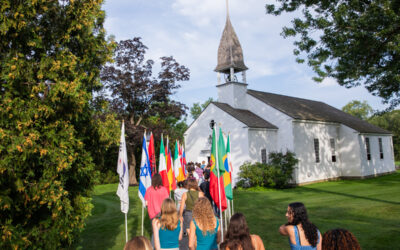Studying old-growth longleaf pines in Georgia, CA students discover more than meets the eye.
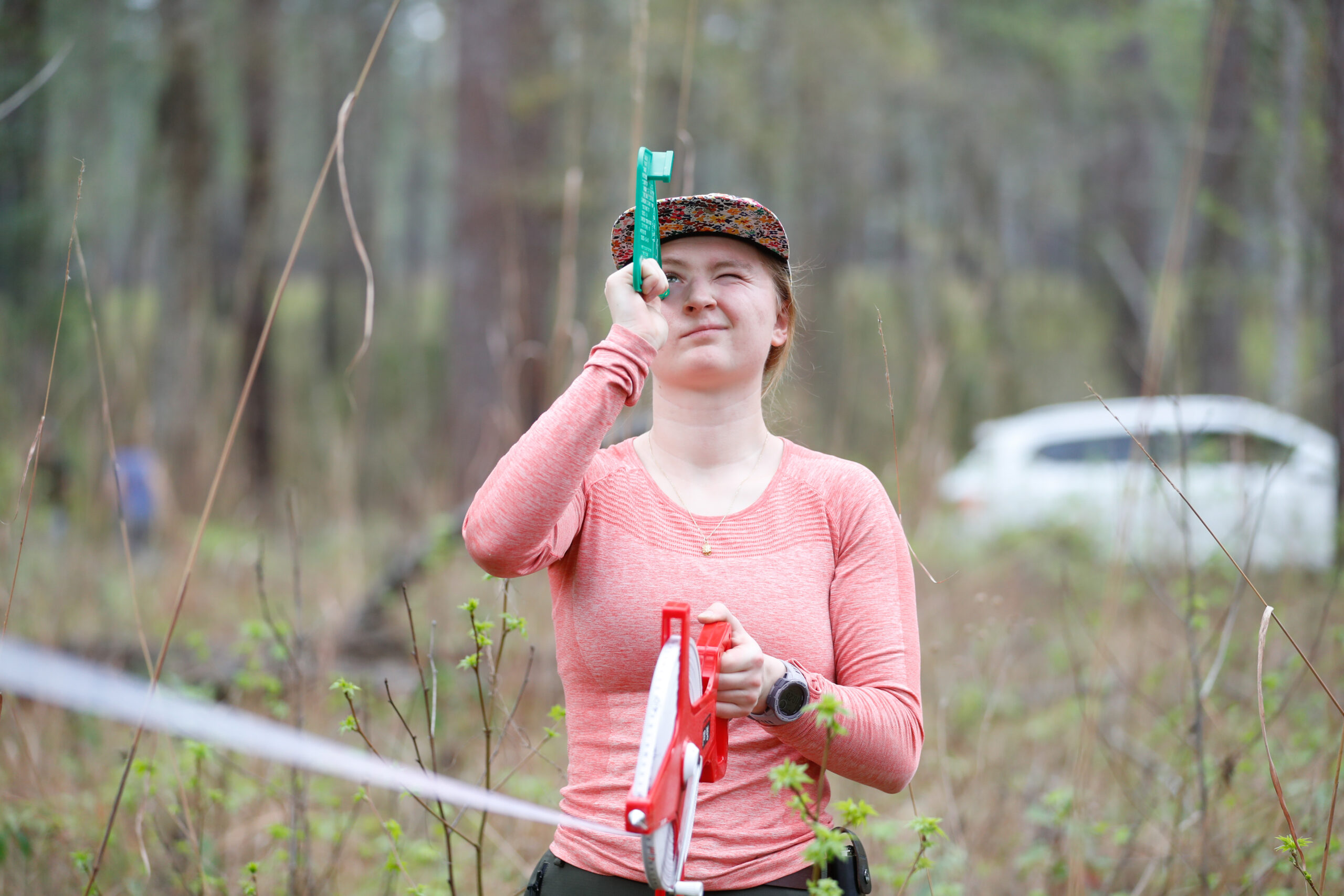
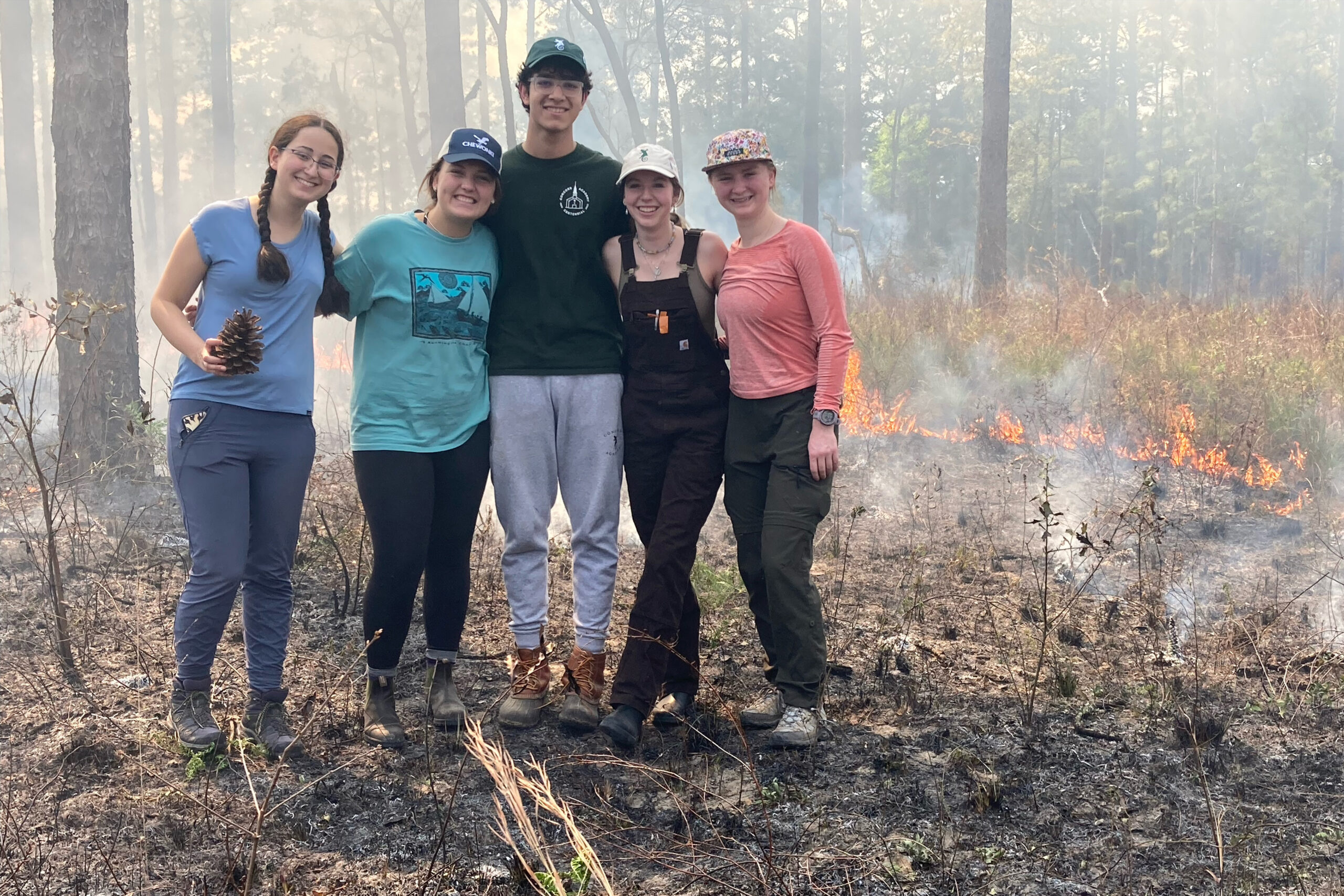

Clockwise from top: Student Annie McGarry ’23 measures a longleaf pine tree plot, Jamie Wade Comstock ’82, P’17, CA students Maya Khalil ’23, Phoebe Fritz ’23, Ishaan Jain ’24, Lucy Baker ’23, and Annie McGarry ’23 at the controlled burn.
BEHIND THE FIRE LINE, pine cones the size of footballs smoldered on the blackened ground. Every step crunched. Some of the students observing the controlled burn turned up the soles of their boots to check if they were beginning to melt. Up close in the sizzle and smoke, it was startling how suddenly a light breeze could lick up the blaze.
“Fire creates its own weather if it’s big enough,” their guide, Paul Massey, told them. “This was one year rough, and you see how it’s goin’ up.” He gestured to where the flames, converging from two directions, were flaring high and orange.
Massy has overseen this springtime ritual in Georgia for four decades. At Arcadia, a private land preserve near Thomasville where he is the property manager, he burns up to 200 acres at a time, the blazes bounded by dirt roads and by firebreaks dug with a harrow and a tractor. The longleaf pine forest native to the area doesn’t just tolerate fire, it thrives on it. Potash from the fire acts as fertilizer, and every species in this habitat relies on the conditions created when the understory is scorched.
The opportunity for students to experience this ecosystem—once dominant but now exceedingly rare—came through a Concord Academy connection. Jamie Wade Comstock ’82, P’17 invited five CA students, selected from a strong pool of applicants, to come to Arcadia the week before spring break, along with trip leaders Gretchen Roorbach P’17 and Jodi Pickle. Thanks to a grant from the Wade Family Foundation, the group received an all-expenses-paid trip from Massachusetts to Georgia to conduct scientific research.
Comstock, the students, and the teachers followed the fire for a good hour. “It’ll burn ’til dark,” Massey told them after a while. “You can stay and watch it,” he added, heading for his truck. Burn-off is business as usual in the Red Hills region near Thomasville, and the students had been hoping the weather would allow them to experience it up close. On the short flight from Atlanta to Tallahassee, Fla., an hour’s drive south, they had glimpsed hundreds of controlled fires—from the air they appeared like wisps of clouds rising from the woods.
They weren’t disappointed. “I was mesmerized,” Lucy Baker ’23 said. With family in Colorado, she understands the havoc wildfires have wreaked in the American West. “I’ve never seen fire like that in such a positive way,” she said.
The students had come to study an old-growth area at Arcadia known as the Wade Tract Preserve. To understand its uniqueness, they first got their bearings by learning the history of the region, exploring other parts of the forest, and enjoying Comstock’s Southern hospitality.
The evening they arrived, she invited them to the low-slung midcentury house her family also calls Arcadia. To reach it, they rode three miles along dusty red-clay lanes through open woods, past a few fields, and, finally, up a steep, root-gnarled track. The house sat high on a small plain, from which mown grass footpaths meandered downhill to two human-made ponds. A bright green Kawasaki 4×4 was parked out front.
Comstock came out to greet them, barefoot in the warmth of March in southwest Georgia. In the late afternoon sun, dogwoods glowed gold on the lawn. The patio was the perfect perch for taking in the landscape: low, rolling hills with sun-flooded pine woodlands, perfectly straight trunks as far as the eye could see.
“I feel a lot of love for the environment here,” Comstock said, ushering the students inside. She opened several sets of sliding doors, turning the brickfloored living room into a breezeway. “I hear so many animals.” Indeed, she later pointed out the croaks of lizards— they’re known to get into the house— and the yips of distant coyotes.
The land that makes up Arcadia had once been part of the neighboring family property, Millpond, more than 10,000 acres Comstock’s great-grandfather Jeptha Homer Wade II had accumulated in parcels by 1906. Like many prominent Cleveland families wanting to overwinter in a milder climate, the Wades had been drawn to the area in the late 1800s, when a resort industry developed around Thomasville, the last stop on the southbound rail line. Initially they managed the property for hunting, with prescribed fires creating conditions ideal for the region’s all-important bobwhite quail (a painted wooden replica took pride of place on the mantel).
Comstock said her parents, Jeptha H. Wade III and Emily “Paddy” Vanderbilt Wade, took on “this third of Millpond to manage differently,” for conservation, in the mid-1970s. “Arcadia was most famous for my mom’s determination to farm organically in the 1970s,” Comstock said. “Now it’s all about longleaf.”
There are similar land tracts in the region, most still in the hands of families from Cleveland. “Many are very conservation-oriented, even if they do privilege the quail habitat,” Comstock said. But at Arcadia, management took a different turn.
In 1961, the biologist Herbert Stoddard wrote to the Wade family to testify to the uniqueness of several hundred acres at Millpond, having never been discernibly logged, “hence in my opinion so valuable for research that none of us living today can foresee all the values the block will have for generations to come.” In 1979, Comstock’s parents formally protected the area Stoddard had identified—what became the Wade Tract—granting a perpetual conservation easement to Tall Timbers Research Station and Land Conservancy. It was the first such conservation agreement made in Georgia. In 2013, the Wade Tract was designated a National Natural Landmark, the best remaining example of the oldgrowth longleaf pine savanna that once blanketed the southeastern United States.
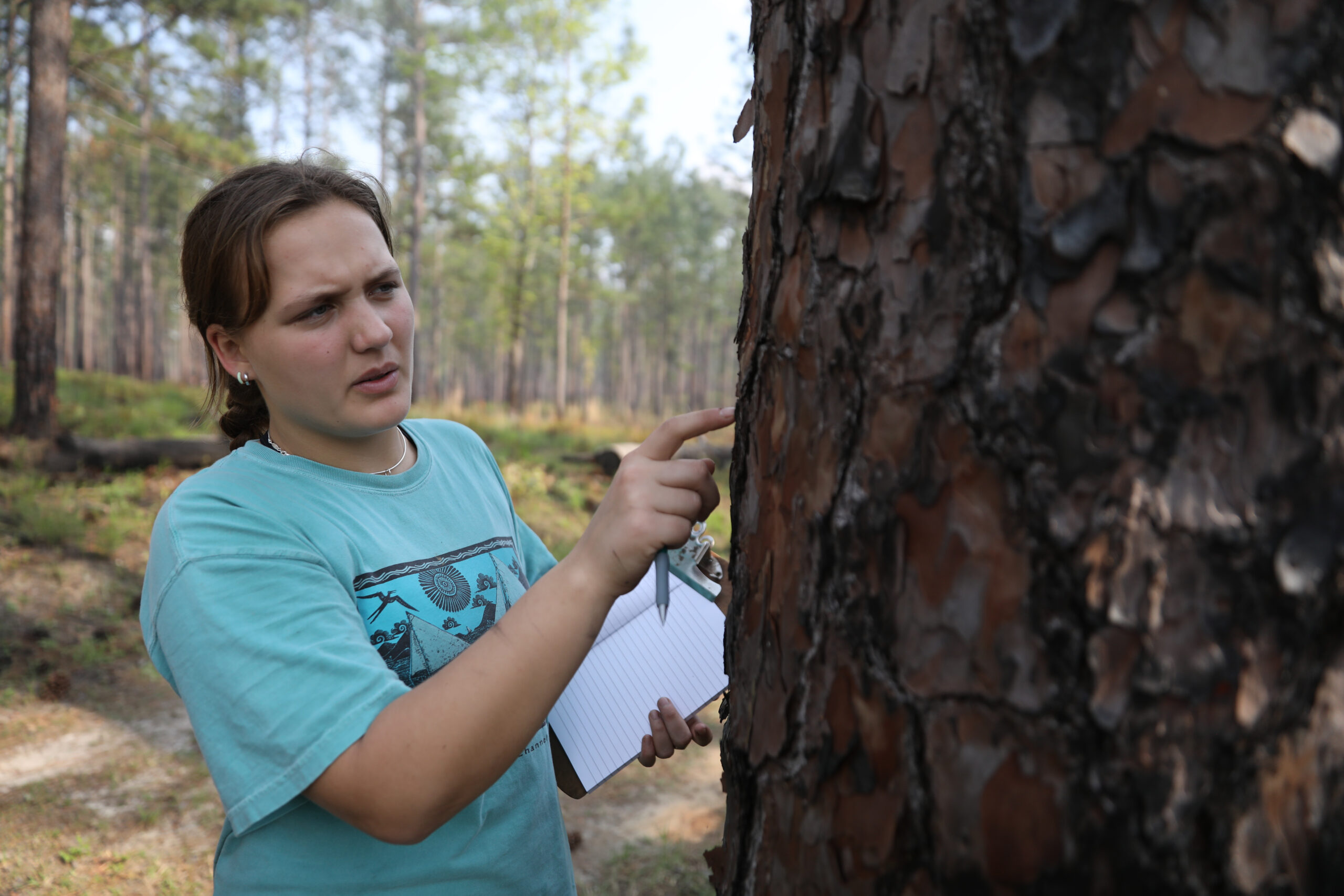
Phoebe Fritz ’23 examines the bark of a 500-year-old longleaf pine tree at the Wade Tract.

Maya Khalil ’23 identifies plants at the Wade Tract.
Today longleaf is one of the rarest forests in North America. Once covering 90 million acres, from Virginia down to Florida and west into Texas, now it’s limited to only 3% of its former range, and most of that is in young, reestablishing forests. These days, setting foot on longleaf habitat that has never been disturbed is an experience of a lifetime.
The day after Comstock’s warm welcome, Massey gave the group a tour of the northern section of Arcadia. Near the house, most of the trees were loblolly pines. “These are around 200 years old,” Massey said casually, with the timing of a seasoned raconteur. “They max out any longer than that. Not like longleaf, that can go on forever.”
Driving some students in his pickup, with others following in the Kawasaki and staying in touch by phone, he described the landscape as they bumped down the dirt tracks. Butterflies and dragonflies surfed the air currents beside the truck, and with the windows down, a fine dust drifted in.
“That’s a kingfisher, you hear him?” Massey called out.
He pointed to areas of low-growing young longleaf pines—they stay in the grass stage up to 10 years while setting down taproots—as well as taller stands, which he explained would thin over time. Longleaf needs sunlight to generate; to prioritize its habitat, Massey said he gradually expands natural openings in timber stands. Throughout the forest, fire had blackened the base of every tree trunk.
As they rode, students and teachers peppered Massey with questions. How old were these trees? Most were between 150 and 350 years old, older still at the Wade Tract. And at Greenwood, a nearby site that Paddy Wade had purchased in 2015 to protect it from development, the oldest tree was pushing 700. How unusual was this land? “Like hen’s teeth,” Massey replied. He takes pride in maintaining the forest as he’d first seen it. “My job is to save trees, not cut trees,” he said. “The problem they seem to have lost sight of is that it takes 200 years to grow a 200-year-old tree.”
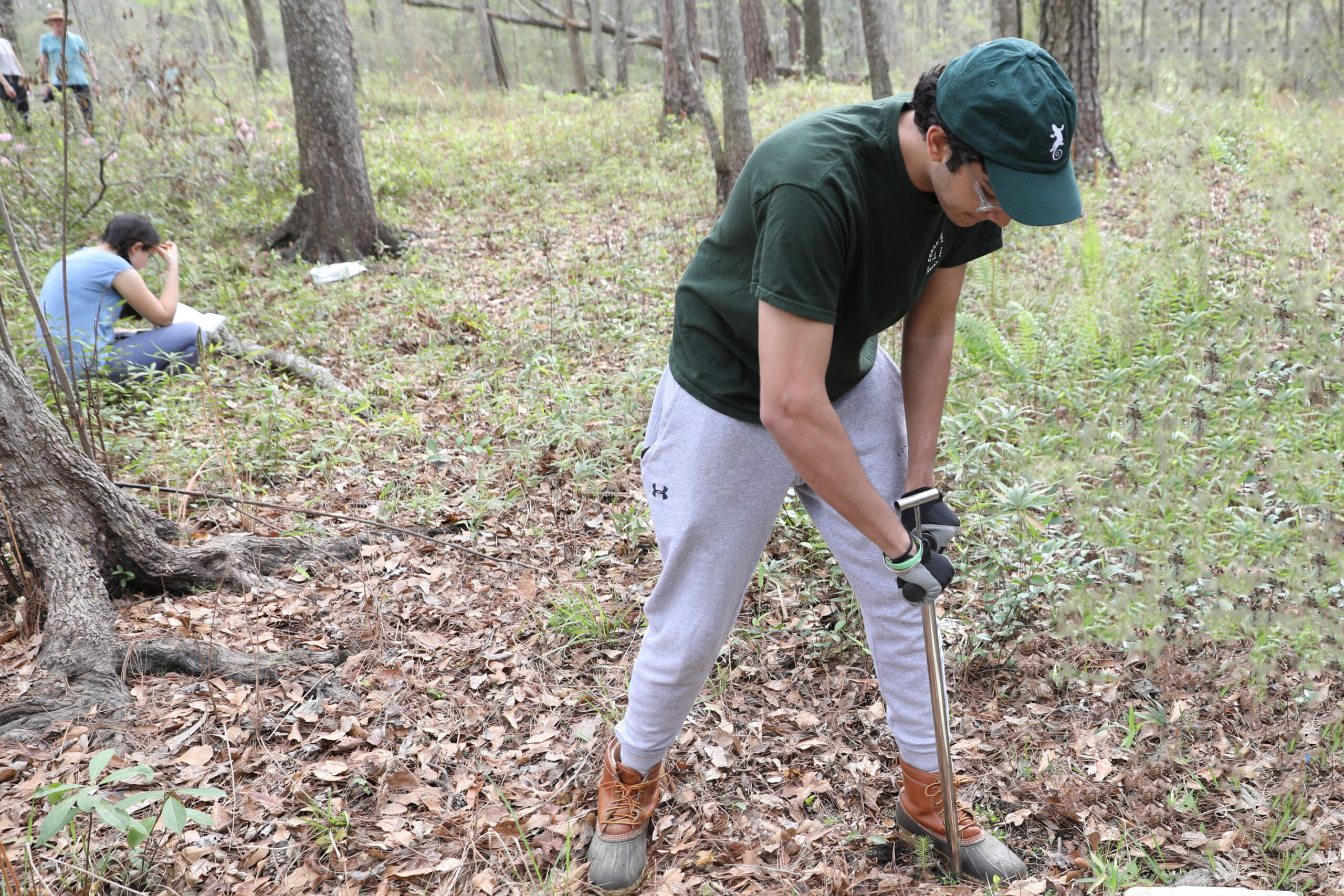
Ishaan Jain ’24 takes a core sample at a different field site at Arcadia.
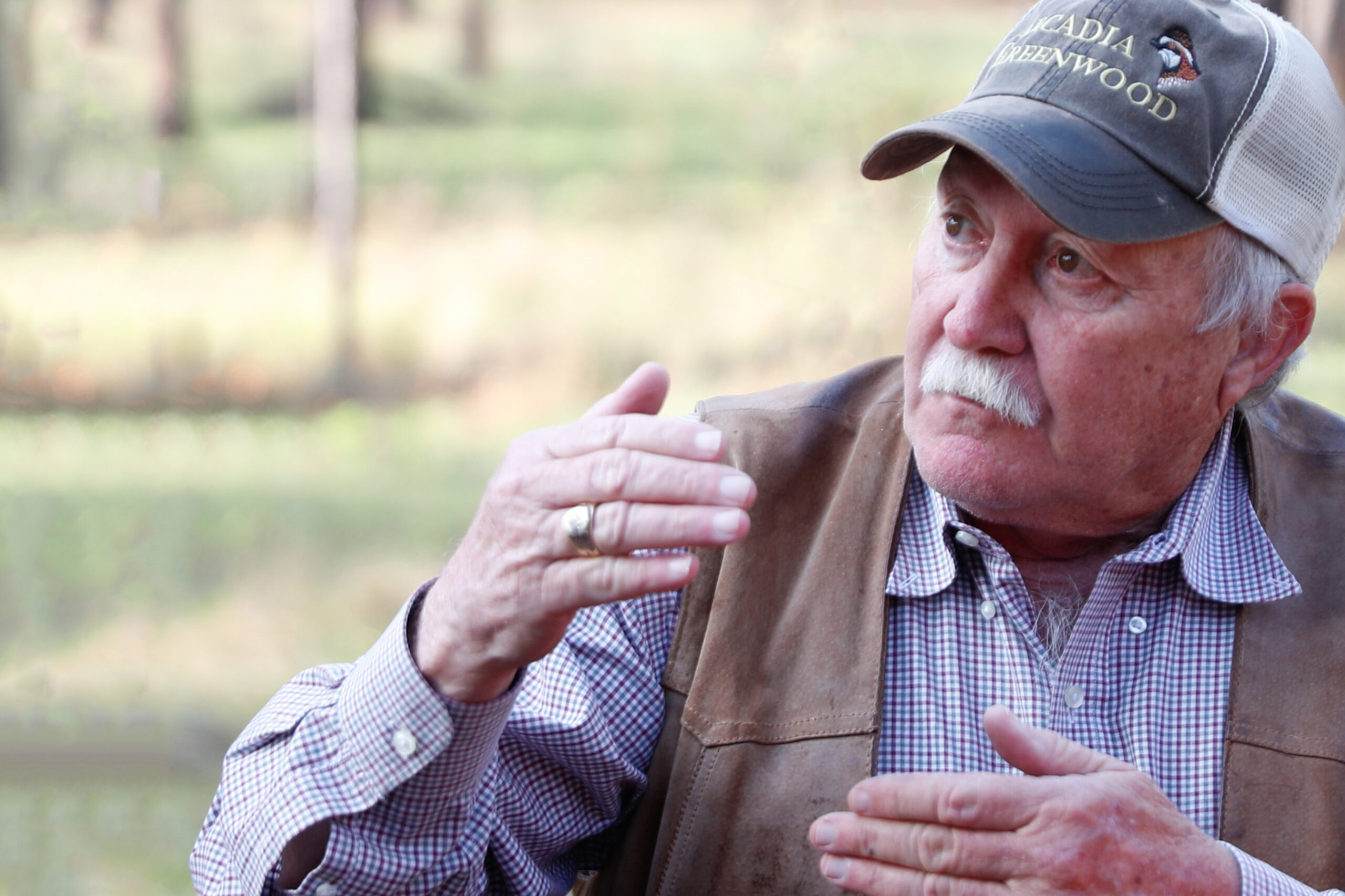
Arcadia property manager Paul Massey gives the group a tour.
When they came to a muddy puddle near a rivulet, Massey stopped the truck and got out to clear fallen branches from the road. The group got out and gathered where he pointed out the tracks of wild boar and noted how the landscape was transitioning. In this ecotone, longleaf pine gave way to pink-blooming redbuds, an aged oak draped in Spanish moss, and a crowd of ferns. In a low area nearby, Roorbach had the students pick out plots to analyze the next day, to compare measures of biodiversity against samples they would later collect at the Wade Tract.
The following morning dawned muggy. Birds called and answered each other in the forest. The students retrieved their instruments, field notebooks, and kit from the back of the Kawasaki, then marked out two 10-meter plots. It was tiring work in the heat amid the thick growth.
Bent over a field guide, Maya Khalil ’23 tried to identify a fern growing by the road. “I want to see the spores of the fertile fronds as they’re developing,” she said, and she clipped a field microscope to her smartphone.
Ishaan Jain ’24 struggled to take a core sample, vigorously twisting the drill but only succeeding in inching it into the ground. Thinking he might be hitting a root, he moved over, but it was still slow going. Eventually, he deposited the sample onto a tray—a couple of inches of loose topsoil, the rest compacted clay. Roorbach called the group over. “Look!” she said. “Here’s the classic Georgia soil profile.”
The students centered their plots around the thickest vegetation, hoping the dense underbrush would offer more species to observe. They set about creating overhead canopy maps and vertical structure diagrams and establishing a biodiversity index. They used purple eyeglasses to detect stressed plants, checked the pH and moisture in the soil, and measured wind speed, temperature, and relative humidity. Phoebe Fritz ’23 settled herself on a log, a birding app’s sound identification visualization spooling across her phone screen, highlighting in turn the song of a Carolina wren, a blue-gray gnatcatcher, a redwinged blackbird.
Pickle rekindled the excitement of her earlier days in the Science Department, happy to be back in the field. “You can recognize how quickly it’s regenerating,” she said— though the area had been burned some six weeks earlier, it was lush and green. She began looking for the source of the sand they’d noticed nearby. The plant density increased near the only place they had seen limestone.
“It won’t start growing significant pines here,” Pickle said, theorizing about the soil and the bedrock beneath as she roamed.
The observation of erosion drew Annie McGarry ’23 over from the research plot, where she’d been squinting along a tree height gauge. At the dirt road, she and Pickle started turning over rocks and found, surprisingly quickly, a number of fossils: crinoids, coral polyps, a slice of clamshell.
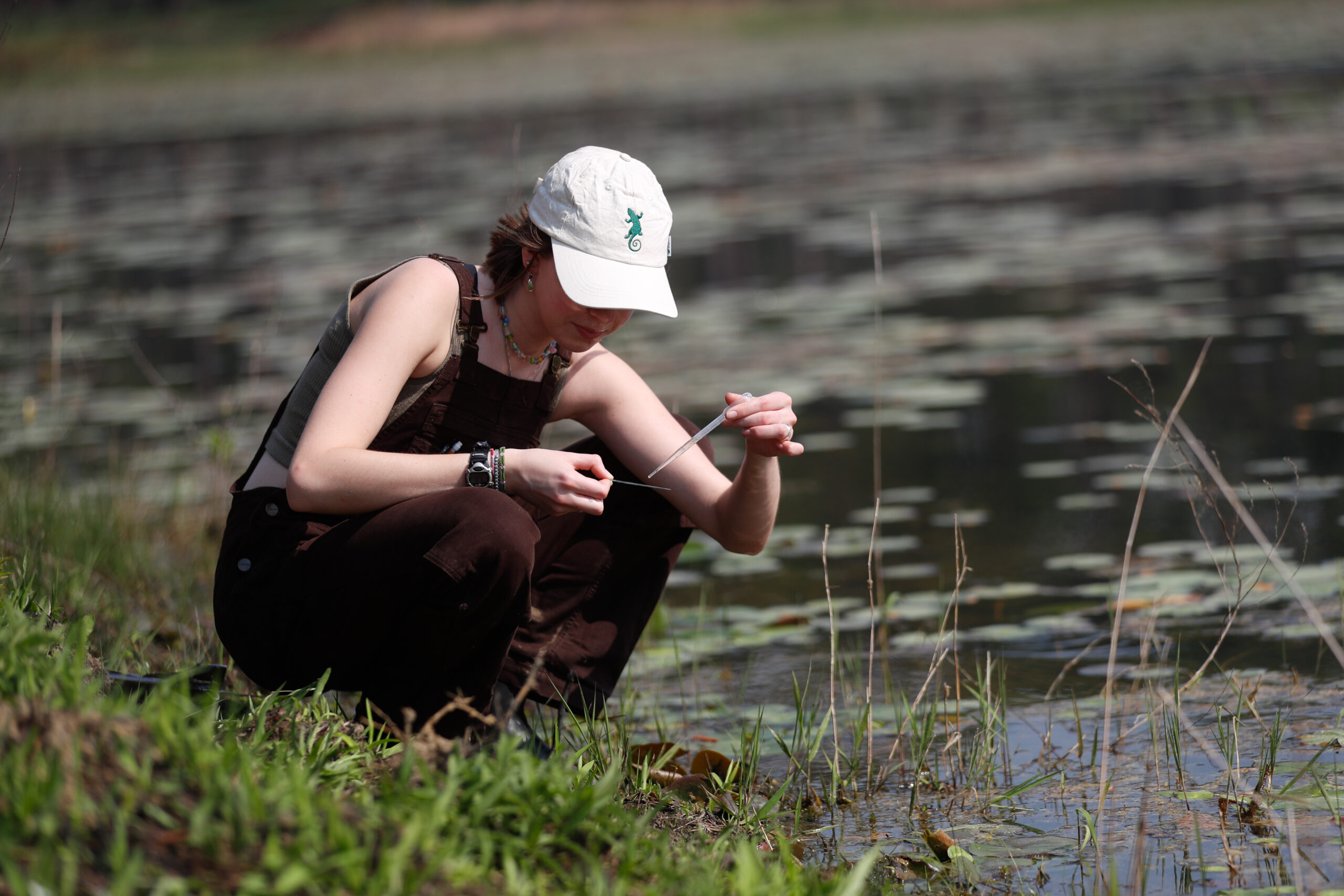
Lucy Baker ’23 takes a water quality sample in one of Acadia’s ponds.
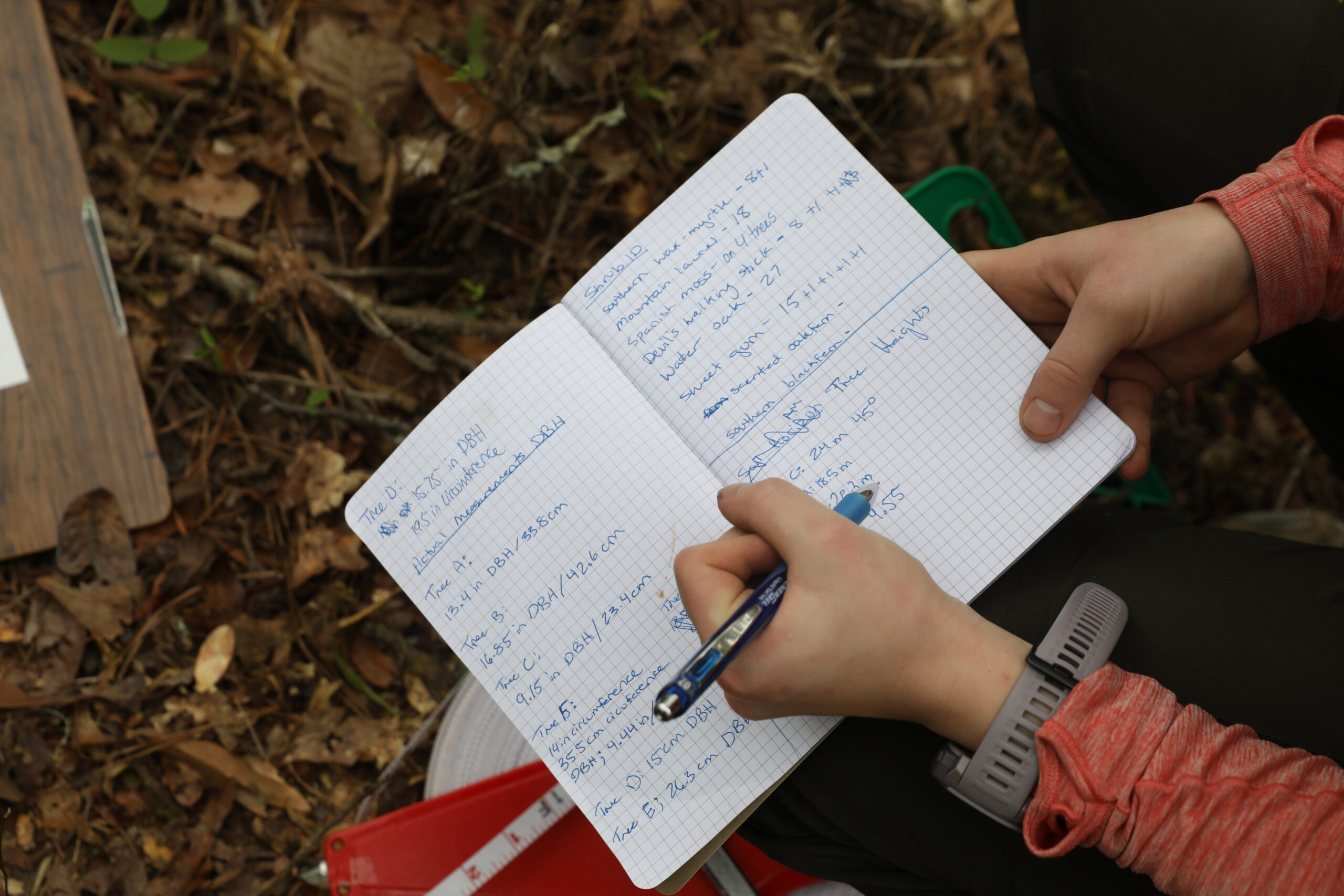
Each student kept a field journal of observations.
“That’s the way life is,” Pickle said. Everything, she suggested, provides clues about its origins. “Isn’t it amazing to learn to read the landscape?” she asked. “You start asking, what am I noticing? Also, what’s not here?”
The following afternoon, when the group took its long-awaited tour of the Wade Tract, some of the students were initially surprised to find that in this highly studied 200-acre plot, every tree was tagged. They had learned that longleaf-dominant forests are some of the most biologically diverse in North America, but it was a challenge to see how that could be. Tall, slim pine trunks stretched up over 100 feet. Trees were spaced widely with an open canopy, little brush, and no low-growing branches. Compared to New England, these were minimalist woods. Someone called it an enchanted forest: It looked like it belonged in a fairy tale.
“It’s hard to explain to my friends up north,” Comstock said. “It doesn’t feel closed-in.” She had come along for a talk with Jim Cox, the site coordinator and director of Tall Timbers’ Stoddard Bird Lab, who has conducted research there for decades.
Tall and slim, Cox was soft-spoken. His love of this environment needing no emphasis, he narrated quickly and with ease. As they moved through the open woods, he invited the students and teachers to notice how their heels sunk into the humus. “These are virgin soils, and you won’t find this anywhere agriculture has been prevalent,” he said. “There’s an entire two feet of what we call the ‘A horizon’ before you get down to the clay soil.”
He recalled coming to the tract the day after a hurricane. “You’d think there’d be all this water sloping off this hill,” he said. “No, it was all going in.”
If witnessing a prescribed fire was the dramatic highlight of the trip, walking through uncut forest was a less dramatic, but deeper experience. Taking it in seemed to require a different kind of vision: seeing below the ground, and on a more-than-human timescale.
“It’s very beguiling,” Cox said a little wistfully. “It’s very simple looking, but it’s not.” At ground level, he explained, more than 50 plants could grow in just one square meter. And the forest is home to several species that depend on old-growth trees and regular fires, such as the endangered red-cockaded woodpecker—with a bird whistle, he drew out five that flew from a nesting cavity high overhead—and the declining Bachman’s sparrow and brown-headed nuthatch. Another fire-tolerant species, ground oak, sprouted up in many places; its root systems are connected underground, and what appeared to be a little shrub could have been a century old.
Pocket gopher mounds rose above the soil, and gopher tortoise burrows vanished below. A “keystone species,” on which others depend, the tortoise has an outsized impact on the ecosystem. More than 200 other species use its burrows, including some that are found nowhere else.
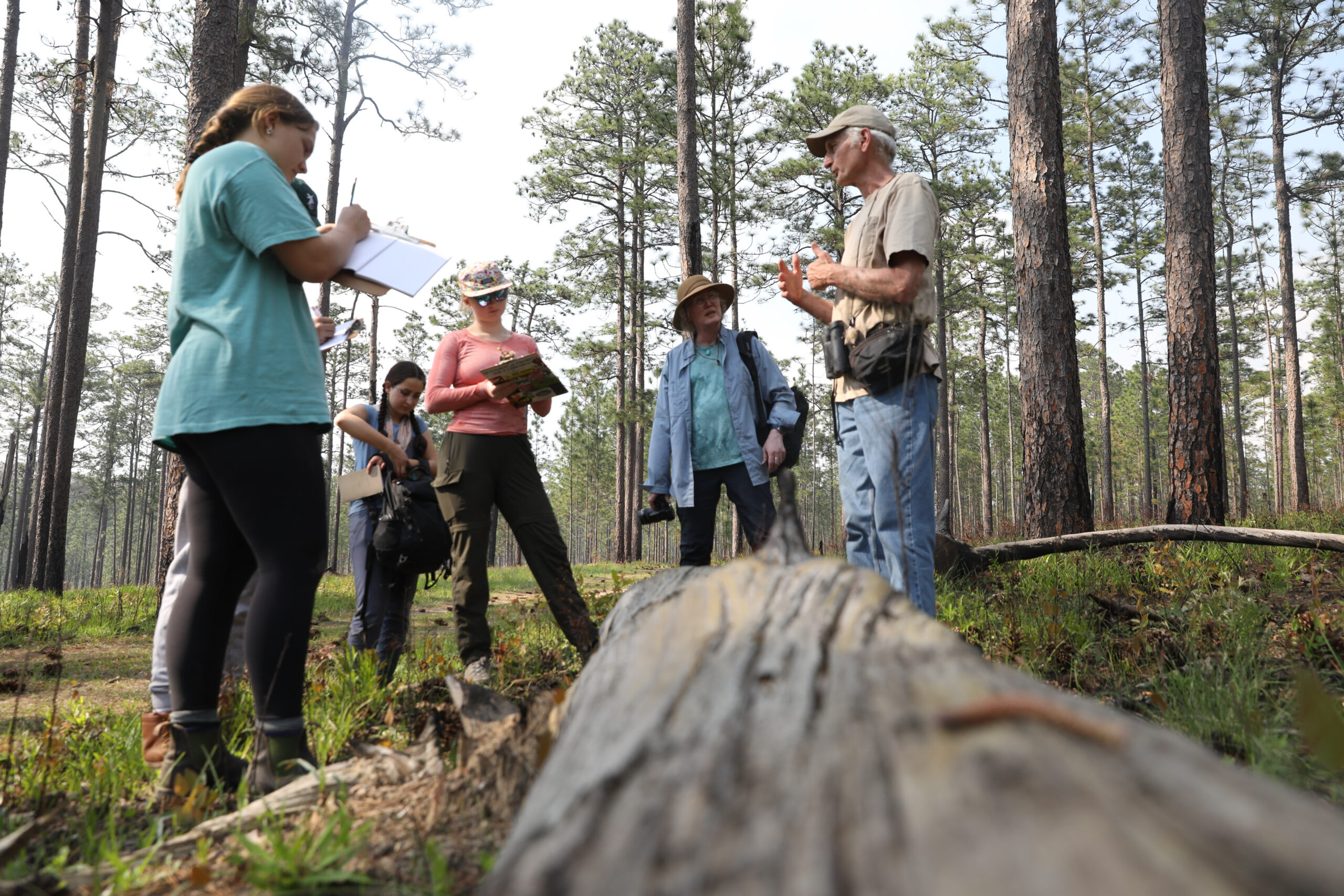
Showing the group a tree that had fallen some 30 years earlier on the Wade Tract, Jim Cox from Tall Timbers talks about the strength and durability of longleaf pine trees.
“What I like about this animal interaction, with the soil, with the fire, with the way the plants grow and develop— it’s a triangle,” Cox said, pointing to a burrow’s entrance, where new longleaf were sprouting in the only place they can: bare soil. The subtle disturbances the tortoises create—kicking up sand while browsing for vegetation—clear the area of pine needles (“one of the most volatile fuels out there, tons of terpenes,” Cox said). That helps establish the oaks, which grow quickly, until eventually the longleaf pines overtake them. When it becomes too shady, the tortoises move on—clearing another area, and readying it for more longleaf. This self-regulating cycle plays out over some 200 years.
80 to 90 years, before it can no longer pull nutrients up the height of its trunk and it starts growing laterally. “They get this bonsai look,” Cox said of the older trees, whose upper branches resembled the curled pine boughs in a Japanese painting. Most longleaf pines continue to age until, usually, they are killed by lightning strikes.
“There’s a 500-year-old tree here,” Cox said quietly. “Oh, can we go?” Lucy asked. “I mean, yeah, it’s right down here.” “Let’s go!” Annie hollered, charging ahead.
The students touched its deep-fissured bark reverently. “Let’s think, guys,” Annie said. “This tree was here when Christopher Columbus came to the Americas.”
The light had gotten long from the west. Each straight trunk became a sundial.
“I can’t really wrap my head around the fact that this has never been disturbed,” Maya said.
“Luck has given us this place,” Cox replied. The train arrived in Thomasville the very month federal troops were fired upon at Fort Sumter in 1861, he explained: Five to eight years later, “we’d have had great transportation for carrying cotton to market— and Arcadia would have looked like the rest of the Southeast, totally turned over to agriculture.”
Before parting from the group, he put the tract’s rarity into perspective. By one estimate, only around 1,200 acres of longleaf pines, out of the original 90 million—or .014%—is uncut oldgrowth, Cox said: “It’s like the world’s population being whittled down to the size of Cleveland.”
On the final morning of the trip, the students journaled in the woods. “I was surprised by how sparse the vegetation was,” Phoebe wrote. “While I know that the biodiversity here is most likely similar to, if not greater than, the biodiversity at the first plot, the understory and brush in the Wade Tract were far less prominent.”
Lucy recalled her first impressions of Arcadia. “It smells so insanely good here. It’s sweet and smoky and humid,” she wrote. “I was surprised by the openness of the forest, the red soil, and how high up the crowns of the trees are.” Others reflected on data that documented the diversity and stability of the Wade Tract.
For her part, Comstock was happy the students had been able to take it all in. “I’m very proud of this place and glad this trip was a success,” she said, “so more CA kids can keep coming to the Red Hills region.”
Story by Heidi Koelz
Photos by Octavio Jones

